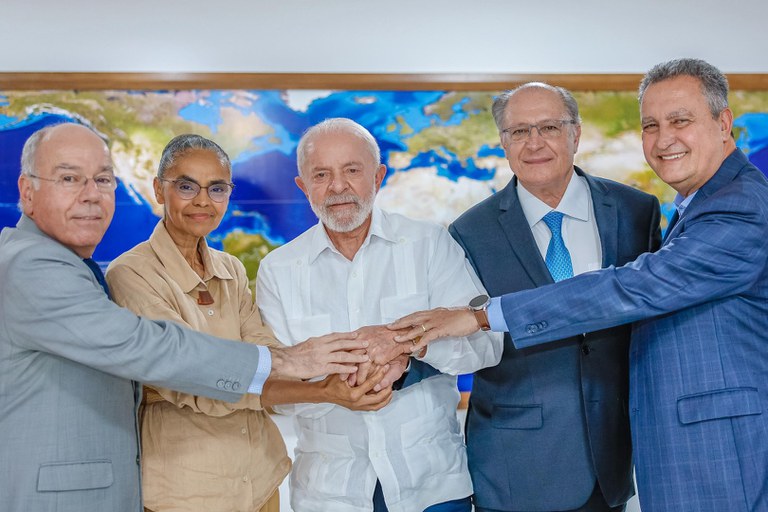Notícias
ENVIRONMENT
Brazil presents its new climate target aligned with Mission 1.5ºC

The Vice President of the Republic, Geraldo Alckmin, head of the Brazilian delegation at COP29, is going to announce the new target at the UN climate conference in Baku, Azerbaijan, from November 11 to 22 - Credit: Ricardo Stuckert/Secom-PR
Brazil’s new climate target for the Paris Agreement will be announced by Vice President Geraldo Alckmin, head of the Brazilian delegation, at the United Nations Framework Convention on Climate Change (UNFCCC). This announcement will take place at COP29, the UN climate conference held in Baku, Azerbaijan, from November 11 to 22.
Brazil’s second Nationally Determined Contribution (NDC) outlines the country’s commitment to reducing net greenhouse gas emissions by 59% to 67% by 2035, relative to 2005 levels. In absolute terms, this target translates to a reduction of 850 million to 1.05 billion tons of carbon dioxide equivalent by 2035.
According to the Global Stocktake (GST) agreed upon at COP28 in Dubai in 2023, the new NDC encompasses all economic sectors and is aligned with the Paris Agreement objective of limiting global average warming to 1.5ºC relative to the pre-industrial era. This commitment will allow Brazil to advance towards climate neutrality by 2050, the long-term target of the climate commitment.
The new target represents a critical stage in promoting a new development model through implementing initiatives such as the Climate Plan, the Ecological Transformation Plan, and the Pact Among the Three Branches of Government for Ecological Transformation.
The NDC results from an extensive assessment of Brazil’s emission scenarios. It acknowledges the urgency of combating the climate crisis, addresses the need to build resilience, and sets a roadmap for a low-carbon future for Brazil’s society, economy, and ecosystems.
PARIS AGREEMENT—It also expands the emissions reduction target presented in the first NDC, consolidating the trajectory of increasing ambition mandated by the Paris Agreement 2015. Compared to the previously established 2030 target, the ambition for absolute emissions reduction has increased by 13% to 29%.
The new NDC presents a range-based target, accounting for variables in future scenario projections and acknowledging that fulfilling this commitment will be shaped by national and global factors through 2035. The NDC also reaffirms Brazil's commitment to enhancing adaptive capacity, strengthening resilience, and reducing vulnerability to climate change.
The path to implementing the NDC is outlined in the Climate Plan, which will guide Brazil’s climate action through 2035. The plan will be divided into two main areas: one focused on reducing the effects of greenhouse gas emissions (mitigation) and the other on adapting to the impacts of climate change. It includes seven sectoral plans for mitigation and sixteen for adaptation.
CLIMATE FUND — To enable this new vision of development, economic instruments such as the Climate Fund (Fundo Clima), Sustainable Sovereign Bonds (Títulos Soberanos Sustentáveis), Eco Invest Brazil, the Brazilian Sustainable Taxonomy (Taxonomia Sustentável Brasileira), and the Tropical Forests Forever Fund (Fundo Florestas Tropicais para Sempre) will be employed.
Brazil’s Federal Government has been working on various fronts to reach its emission reduction targets. The most important one is combating deforestation.
Last Wednesday (November 6), the official deforestation rate in the Amazon was announced, showing 6,288 km² of deforestation between August 2023 and July 2024, according to estimates from Brazil’s National Institute for Space Research (INPE) PRODES system. This represents a 30.63% reduction compared to the previous period, marking the most significant percentage drop in 15 years.
CERRADO - In the Cerrado biome, the official deforestation rate between August 2023 and July 2024 was 8,174 km², the lowest since 2019. This data represents a 25.7% drop compared to the previous period (August 2022 to July 2023) and marks the first reduction in deforestation rates in the biome in five years.
Reductions in deforestation—Brazil’s primary source of greenhouse gas emissions—over the first two years of the current administration have prevented the release of 400.8 million tons of CO₂ equivalent in these two biomes.
Several other measures are underway, such as the ABC+ Plan, the Fuel of the Future Plan (Plano Combustível do Futuro), the Degraded Pasture Recovery Program (Programa de Recuperação de Pastagem Degradada), the Energy Transition Plan (Plano de Transição Energética), the New Industry Brazil Program (Programa Nova Indústria Brasil), Planaveg, the Productive Forests Program (Programa Florestas Produtivas), Deforestation Prevention and Control Plans (Planos de Prevenção e Controle do Desmatamento) in every biome, among others.